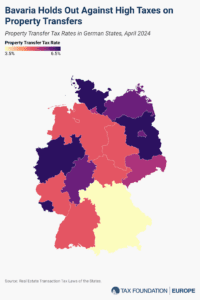
Assessing the EU Tax Observatory’s View on Profit Shifting and the Global Minimum Tax
6 min readBy:Last month, the EU Tax Observatory released a report documenting “Global TaxA tax is a mandatory payment or charge collected by local, state, and national governments from individuals or businesses to cover the costs of general government services, goods, and activities. Evasion.” The word “evasion” might suggest something illegal is going on, yet the authors admit in the executive summary that they are not documenting tax fraud. Instead, the goal of the inflammatory language—and the report itself—is to argue for the EU Tax Observatory’s preferred policy goals.
The report takes an extreme point of view in the context of multinational companies and the global minimum tax. The metrics used in the report and corresponding rhetoric suggest that the authors would be willing to support drastic measures to satisfy their concerns.
In this post, I’ll address two portions of the arguments made in the report.
First, the logic the authors use to assess the global minimum tax suggests they would be comfortable with a regime of capital controls that limit the ability of multinational companies to generate profits in low-tax jurisdictions (regardless of whether they are subject to the global minimum tax).
Second, the authors rewrite the history of an important piece of the global minimum tax that has been part and parcel of the debate from the beginning. Their choice to label the carve-out for economic substance as a “weakening” of the global minimum tax reveals that they do not understand the purpose (both economic and political) of the carve-out in the first place.
Level Up the Global Minimum Tax to a Capital Controls Framework?
The EU Tax Observatory’s problem with recent levels of profit shiftingProfit shifting is when multinational companies reduce their tax burden by moving the location of their profits from high-tax countries to low-tax jurisdictions and tax havens. boils down to a classic stock vs. flow problem. The authors are clearly concerned about the level of profit shifting, despite the fact that new profit shifting has slowed (even before the global minimum tax’s implementation).
Think about a bathtub with water running into it. You can observe the level of water in the tub, and you can observe the amount of water running into it.
In the context of profit shifting, low-tax jurisdictions are the tub, and intangible assets or profitable activities that can be moved across borders with relative ease are the water. Governments can limit new profit shifting with anti-avoidance policies, thus turning down the tap.
Policy changes in recent years have undoubtedly limited the flow of new profits into low-tax jurisdictions by either directly curtailing the avoidance opportunities or making profit shifting relatively less attractive (e.g., the global minimum tax). However, the historical stock of activities and assets in low-tax jurisdictions still generate significant profits. Even if you turn off the faucet completely, the tub still has water in it.
Normal bathtubs have a drain. A drain in the international tax system could come in a few different forms. One is making other jurisdictions relatively more attractive to entice profits away from the low-tax jurisdictions over time.
Profits that have been shifted to low-tax jurisdictions are often associated with valuable intellectual property (IP) that has been developed elsewhere. If, due to the minimum tax, companies become less likely to shift new IP and associated profits to low-tax jurisdictions, then, over time, the bathtub full of shifted profits will be less important. Fewer and fewer profits will be moved out of high-tax jurisdictions for the sake of a lower tax bill.
However, companies that have assets and profits in low-tax jurisdictions may feel that those arrangements are stuck; once the minimum tax is enforced, unwinding those arrangements could create significant tax bills. It may be more efficient to leave profits in low-tax jurisdictions, pay the minimum tax, and adjust plans for future investments.
Another way to drain the tub of shifted profits would be to force the earnings and associated activities and assets out of the jurisdictions where some authority determines they “should not be” into the jurisdiction where they “belong.”
What would this require? First, it would require some sort of expropriation or punitive tax regime to force profits to move from where they currently are. Second, it would require a clear definition of where profits should not be. Third, it would require companies to be forced to report their profits where they supposedly belong. Finally, it would require a capital controls framework to keep high levels of profitability out of low-tax jurisdictions.
The logic used by the EU Tax Observatory would lead to some form of that policy. Figure 2 of the report shows that the growth in the stock of shifted profits has stalled in recent years. Figure 2.1 shows high levels of profits in low-tax jurisdictions relative to employee compensation.
In this view of the world, if companies have profitability that is too high relative to payroll, then their profits should be elsewhere.
It is hard to conclude that the authors would be satisfied with a set of rules that allow high levels of profits relative to payroll to continue, even if those profits are facing higher levels of taxation under the global minimum tax. The authors do not go so far as to say that a regime of global capital controls that restricts investment or activity in low-tax jurisdictions is desirable, but the amendments the authors would like to make to the global minimum tax suggest otherwise.
Substance or a Loophole?
The report identifies what the authors refer to as “weaknesses” in the global minimum tax. Among these is the carve-out for economic substance. The global minimum tax allows companies to exclude 8 percent of the carrying value of tangible assets and 10 percent of payroll from the minimum tax calculation in the first year, and by the 10th year, the carve-out will be five percent for each.
The report states, “The carve-outs were introduced relatively late in the negotiation.” The authors do not define “late,” but their statement is clearly false. The 2020 report on the Pillar Two Blueprint included carve-outs for both payroll and tangible assets. The policy that inspired some of the design of the global minimum tax, the 2017 U.S. tax on global intangible low-taxed income (GILTI), has a 10 percent exclusion for tangible assets. Finally, a 2013 proposal from economists Harry Grubert and Rosanne Altshuler that inspired both GILTI and the global minimum tax also proposed a deduction for tangible investments.
A substance carve-out is not a weakening of the global minimum tax; it is integral to it. The goal of the policy is to increase taxes on instances of profit shifting without underlying economic substance, not to set the rules for how to tax economically substantive cross-border arrangements.
As I wrote in 2021, exempting substance is about mitigating the negative impact of a global minimum tax on economic activities. Policymakers are interested in reducing profit shifting, but this desire is tempered with a desire to avoid over-burdening genuine cross-border investment. The substance carve-out plays a meaningful role in balancing these desires. Policymakers have realized there are economic consequences to dramatically increasing taxes and that new distortions to investment and hiring should be limited.
However, eliminating a carve-out for substance does fit the logic the EU Tax Observatory uses to suggest a tighter and more extreme minimum tax that would be tantamount to capital controls for any company choosing to invest or hire in a low-tax jurisdiction.
Conclusion
The EU Tax Observatory has taken an extreme view in assessing the global minimum tax. The rules were not meant to immediately reduce the stock of shifted profits or align profitability levels more closely with employment costs. The rules do change incentives for multinationals, but profits may continue to remain in low-tax jurisdictions for many years. Additionally, the Observatory’s criticism of the substance carve-out rings hollow.
The global minimum tax is a complex behemoth of a tax policy, and there are numerous criticisms that can be levied at it either with a desire to see it weakened or strengthened.
The EU Tax Observatory’s preference is clearly for the latter, regardless of its economic effects or how punitive the rules must be to achieve it.
Stay informed on the tax policies impacting you.
Subscribe to get insights from our trusted experts delivered straight to your inbox.
Subscribe
